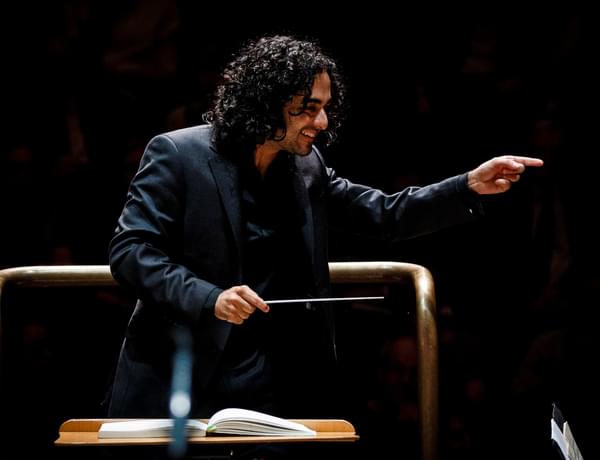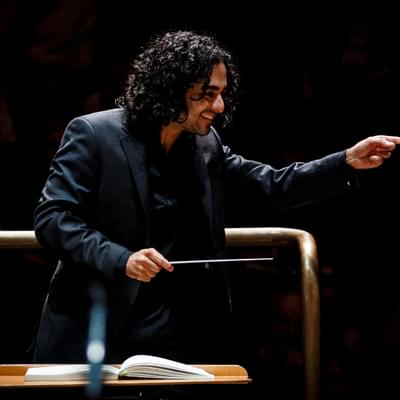Grieg & Beethoven

Full programme
- Valerie Coleman, Umoja: Anthem for Unity (11mins)
- Grieg, Piano Concerto (30mins)
- Beethoven, Symphony No.4 (34mins)
Performers

Kerem Hasan
Conductor
Steven Osborne
Piano
Introduction
I am always excited to put together programmes with any orchestra I work with. Do we put together something connected by a theme, or a moment in each composer’s life that resonates across the centuries, or do we offer ideas based on a particular country’s musical output? The possibilities are endless. In the case of this concert, it is the intense lyricism and rhythmic drive of each of the three composers that unites this delightful concert.
Beethoven’s Fourth Symphony has long been a work I have cherished conducting, it sits (some might say unfortunately) sandwiched in between the mighty Eroica symphony, and the most famous piece of classical music in the world, Beethoven’s Fifth. But the Fourth Symphony is no trivial work! It is a work of genius, pushing the boundaries of rhythmic development, harmony and structure within the classical form, but without the revolutionary effects of its colossal siblings.
The fourth looks back fondly on the music of Haydn, deploying Beethoven’s smallest orchestra delightfully but no less effectively than any of his other compositions. The lighter atmosphere, effervescent string and wind writing fills the work with a humour and ‘joie de vivre’ that genuinely surprises us, given the turmoil that pervaded Beethoven’s life.
The sweet melodies we find in Valerie Coleman’s “Umoja” offer a wonderfully optimistic start to the programme. The Swahili translation for “Unity”, Valerie Coleman offers us a wonderful insight into the call and response techniques used throughout the African diaspora. I am so excited to be presenting Valerie Coleman’s work as she is rightfully deserving of every success that comes her way!
Finally, I’m not sure if Steven Osborne will remember that he gave me piano masterclasses well over a decade ago while I studied at the Royal Conservatoire of Scotland, but to reconvene on the stage with the CBSO, and Grieg’s ever popular and beloved piano concerto is a real treat – one that I cannot wait to be a part of.
I am so excited to present this wonderfully eclectic programme that offers an assortment of diversity and musical thought.
Kerem Hasan
Conductor
Programme Notes
Coleman’s Umoja evolved from a simple, beautiful song for women’s voices to an arrangement for chamber ensemble, to becoming gloriously ‘unified’ in this orchestral version. Steven Osborne works his magic with Grieg’s famous concerto, while Beethoven charms in his breezy, elegant Fourth Symphony.
Umoja: Anthem for Unity
Valerie Coleman (b. 1970)
Coleman’s Umoja has gone through several transformations over the years. It began life as a simple ‘call and response’ song for women’s voices, with the words ‘Listen my people/Children of ALL/It’s time for Unity/Hear the winds call (Oh a-hum a-hum Nkosi ah…)’. ‘Umoja’ is the Swahili word for unity, as well as the first principle of the week-long African diaspora holiday Kwanzaa (it is also the name of a ‘matriarchal’ village in Kenya, a women-only community for those escaping male violence). In 2001 Coleman, a flautist as well as composer, arranged the song for her wind group Imani Winds, the principal melodies converted into a rhythmic swing and the lines of woodwind weaving playfully in and out of each other. Nearly two decades later, Coleman was commissioned by the Philadelphia Orchestra to expand Umoja into orchestral form. Coleman triples – at least – the length of the wind arrangement, and the result suggests considerably more struggle to arrive at ‘Unity’. It opens peacefully, with an atmospheric awakening mainly for tuned percussion. Out of this texture the main ‘unity’ theme emerges on a solo violin, shortly after echoed by trumpet. The central passage is considerably more agitated as various attempts by the theme to return are obscured by hectic, sometimes discordant activity. The sparkling optimism of the final moments is well-deserved – and keenly felt: as Coleman put it, ‘Umoja has to ring as a strong and beautiful anthem for the world we live in today.’
Piano Concerto
Edvard Grieg (1843-1907)
When André Previn died in 2019 tributes in the press came thick and fast, generously paying homage to a great and multi-faceted musician. In the United Kingdom, nearly all of the headlines concerned his famous appearance in the 1971 Morecambe and Wise Christmas special, conducting Grieg’s Piano Concerto (by Grieg). As such, this work has a special place in the heart of British listeners of a certain age, and (especially the opening bars) can be tainted with over-familiarity. But it still has the capacity to surprise, as might the following two facts: it is the only concerto Grieg composed, and he was a mere 24 years old when he wrote it.
Grieg was a virtuoso concert pianist and while he did not give the premiere of his Concerto in 1869 he performed the solo part on other occasions, especially when touring in Europe. It is a deeply personal work, shot through with Norwegian folk melodies, and containing a musical ‘fingerprint’ which would appear in many of his subsequent pieces: the opening three notes (A,G#,E) comprising a falling minor second and a falling major third.
Following the opening timpani roll and mini-cadenza on the piano, soloist and orchestra romp through a breathtaking series of themes, numbering four showstoppers by the third minute, the last of which is sumptuously romantic. As if in celebration, the piano plays another mini cadenza, followed by an orchestral version of the opening theme in a boisterous major key. And so it continues: variations on the opening themes, alternating with and commenting on each other, plus some touching solo spots for several instruments. The piano lets rip in a more sustained cadenza towards the close of the movement, followed by an orchestral rounding-up of various themes in the final bars.
The Adagio movement has a lyrical grace and a yearning quality to its principal theme. A decorative piano melody in the middle section leads to some agitation of its calm surface, but overall the mood is serene throughout. The final movement pays tribute to the Norwegian ‘Halling’ folk dance in its rollicking opening bars, then harks back to the Adagio with a swooningly gorgeous second theme, initially introduced by the flute. In a dramatic piano version of this theme in the closing seconds, Grieg flattens the second: not perhaps the most thrilling gesture on paper, but observe the effect it had on Franz Liszt on hearing it the first time. Liszt marched about the room bellowing the theme, flinging his arms out and declaring ‘G, G, not G sharp! Splendid! That’s the real thing!.’
Symphony no.4
Ludwig Van Beethoven (1770-1827)
Beethoven’s fourth symphony can often be overlooked, perhaps because it is sandwiched between two of his most famous works: Symphony no.3 (the mighty ‘Eroica’) and no.5 (the one with the famous opening). Robert Schumann described no.4 somewhat belittlingly as ‘a slender Greek maiden between two Norse Gods’. But while it is considerably more modest in proportions than its immediate siblings, less obviously laying claim to ‘mightiness’, it has enough crackling energy and surprising twists and turns to fully earn its place in the remarkable set of symphonies Beethoven composed between 1800 and 1824.
When Beethoven began his symphonic journey he was in the mood to shake things up. 1800 marked a new century, complete with a new European Emperor, Napoleon. The Emperor’s journey from humble Corsican soldier to First Consul of the French Republic were hugely admired by Beethoven, who identified with Napoleon’s self-made triumphs. As Martin Geck puts it: ‘Beethoven felt the greatest admiration for a man who had achieved the most tremendous feats through his genius alone’. Napoleon was perceived as a true revolutionary, a phoenix rising from the ashes of the French Revolution, the original ideals of which had gone disastrously sour. In this spirit, and although his hero-worship of Napoleon cooled considerably in later years, Beethoven was setting himself up as a revolutionary composer.
He achieved this through various means, such as dramatic gesture (the openings of the third and fifth symphonies, the hushed, fragmentary beginning of the ninth) and in all of his works through startling contrasts of loud and soft, as if applying electric shocks to a potentially complacent audience. The end of the slow introduction to the Symphony no.4 is one such moment. It is initially dark and suspenseful, appearing to slow down time itself. A sudden loud blast ushers in an entirely different mood for the rest of the movement: one of boisterous good humour, bursting with galloping themes. The slow movement glides calmly along for the most part, flowing with beautiful melodies. Yet a flurry of stuttering, broken rhythms briefly disturbs the peace, and Beethoven seems to be lightly mocking his own serenity with some witty variations in the accompaniment.
The third movement opens with a scampering, trickily rhythmic section, alternating with a dance-like theme in the woodwind. The horn occasionally heckles noisily from the sidelines. The sense of play – which has been strong throughout – is utterly to the fore in the riotous finale, with fiendish flurries of notes for the entire orchestra, the bass line bordering on raucous, and the whole movement barely pausing for breath.
The symphony was completed in 1806 – commissioned by a wealthy Prince for his private orchestra - and premiered the following year to a somewhat mixed reception. Fellow composer Weber wrote, brutally, ‘it capers about like a wild goat to execute the no-idea of Mr Composer’. Berlioz, by contrast, believed the slow movement to be the work of the ‘Archangel Michael’. A curiously backhanded review in 1811 celebrated the relative normality of this symphony compared to others: ‘the occasional strange turns and [those] that impede the effect rather than enhancing it, with which B. has lately driven some players away and some listeners crazy, are not in abundance here.’
Those ‘strange turns’ are, today, largely what listeners find fascinating about Beethoven; and there are in fact enough of them in no.4 to make this a riveting piece to listen to.
© Lucy Walker